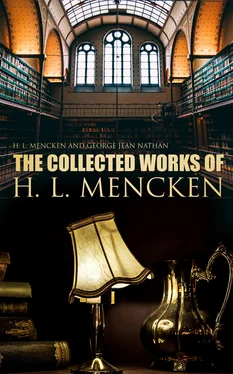George Nathan - The Collected Works of H. L. Mencken
Здесь есть возможность читать онлайн «George Nathan - The Collected Works of H. L. Mencken» — ознакомительный отрывок электронной книги совершенно бесплатно, а после прочтения отрывка купить полную версию. В некоторых случаях можно слушать аудио, скачать через торрент в формате fb2 и присутствует краткое содержание. Жанр: unrecognised, на английском языке. Описание произведения, (предисловие) а так же отзывы посетителей доступны на портале библиотеки ЛибКат.
- Название:The Collected Works of H. L. Mencken
- Автор:
- Жанр:
- Год:неизвестен
- ISBN:нет данных
- Рейтинг книги:4 / 5. Голосов: 1
-
Избранное:Добавить в избранное
- Отзывы:
-
Ваша оценка:
- 80
- 1
- 2
- 3
- 4
- 5
The Collected Works of H. L. Mencken: краткое содержание, описание и аннотация
Предлагаем к чтению аннотацию, описание, краткое содержание или предисловие (зависит от того, что написал сам автор книги «The Collected Works of H. L. Mencken»). Если вы не нашли необходимую информацию о книге — напишите в комментариях, мы постараемся отыскать её.
The Philosophy of Friedrich Nietzsche
A Book of Burlesques
A Book of Prefaces
In Defense of Women
Damn! A Book of Calumny
The American Language
The American Credo
Heliogabalus: A Buffoonery in Three Acts
Ventures Into Verse
The Collected Works of H. L. Mencken — читать онлайн ознакомительный отрывок
Ниже представлен текст книги, разбитый по страницам. Система сохранения места последней прочитанной страницы, позволяет с удобством читать онлайн бесплатно книгу «The Collected Works of H. L. Mencken», без необходимости каждый раз заново искать на чём Вы остановились. Поставьте закладку, и сможете в любой момент перейти на страницу, на которой закончили чтение.
Интервал:
Закладка:
The church we are in is like the neighborhood and its people: well-to-do but not fashionable. It is Protestant in faith and probably Episcopalian. The pews are of thick, yellow-brown oak, severe in pattern and hideous in color. In each there is a long, removable cushion of a dark, purplish, dirty hue, with here and there some of its hair stuffing showing. The stained-glass windows, which were all bought ready-made and depict scenes from the New Testament, commemorate the virtues of departed worthies of the neighborhood, whose names appear, in illegible black letters, in the lower panels. The floor is covered with a carpet of some tough, fibrous material, apparently a sort of grass, and along the center aisle it is much worn. The normal smell of the place is rather less unpleasant than that of most other halls, for on the one day when it is regularly crowded practically all of the persons gathered together have been very recently bathed.
On this fine morning, however, it is full of heavy, mortuary perfumes, for a couple of florist’s men have just finished decorating the chancel with flowers and potted palms. Just behind the chancel rail, facing the center aisle, there is a prie-dieu, and to either side of it are great banks of lilies, carnations, gardenias and roses. Three or four feet behind the prie-dieu and completely concealing the high altar, there is a dense jungle of palms. Those in the front rank are authentically growing in pots, but behind them the florist’s men have artfully placed some more durable, and hence more profitable, sophistications. Anon the rev. clergyman, emerging from the vestry-room to the right, will pass along the front of this jungle to the prie-dieu, and so, framed in flowers, face the congregation with his saponaceous smile.
The florist’s men, having completed their labors, are preparing to depart. The older of the two, a man in the fifties, shows the ease of an experienced hand by taking out a large plug of tobacco and gnawing off a substantial chew. The desire to spit seizing him shortly, he proceeds to gratify it by a trick long practised by gasfitters, musicians, caterer’s helpers, piano movers and other such alien invaders of the domestic hearth. That is to say, he hunts for a place where the carpet is loose along the chancel rail, finds it where two lengths join, deftly turns up a flap, spits upon the bare floor, and then lets the flap fall back, finally giving it a pat with the sole of his foot. This done, he and his assistant leave the church to the sexton, who has been sweeping the vestibule, and, after passing the time of day with the two men who are putting up a striped awning from the door to the curb, disappear into a nearby speak-easy, there to wait and refresh themselves until the wedding is over, and it is time to take away their lilies, their carnations and their synthetic palms.
It is now a quarter past eleven, and two flappers of the neighborhood, giggling and arm-in-arm, approach the sexton and inquire of him if they may enter. He asks them if they have tickets and when they say they haven’t, he tells them that he ain’t got no right to let them in, and don’t know nothing about what the rule is going to be. At some weddings, he goes on, hardly nobody ain’t allowed in, but then again, sometimes they don’t scarcely look at the tickets at all. The two flappers retire abashed, and as the sexton finishes his sweeping, there enters the organist.
The organist is a tall, thin man of melancholy, uræmic aspect, wearing a black slouch hat with a wide brim and a yellow overcoat that barely reaches to his knees. A pupil, in his youth, of a man who had once studied (irregularly and briefly) with Charles-Marie Widor, he acquired thereby the artistic temperament, and with it a vast fondness for malt liquor. His mood this morning is acidulous and depressed, for he spent yesterday evening in a Pilsner ausschank with two former members of the Boston Symphony Orchestra, and it was 3 A. M. before they finally agreed that Johann Sebastian Bach, all things considered, was a greater man than Beethoven, and so parted amicably. Sourness is the precise sensation that wells within him. He feels vinegary; his blood runs cold; he wishes he could immerse himself in bicarbonate of soda. But the call of his art is more potent than the protest of his poisoned and quaking liver, and so he manfully climbs the spiral stairway to his organ-loft.
Once there, he takes off his hat and overcoat, stoops down to blow the dust off the organ keys, throws the electrical switch which sets the bellows going, and then proceeds to take off his shoes. This done, he takes his seat, reaches for the pedals with his stockinged feet, tries an experimental 32-foot CCC, and then wanders gently into a Bach toccata. It is his limbering-up piece: he always plays it as a prelude to a wedding job. It thus goes very smoothly and even brilliantly, but when he comes to the end of it and tackles the ensuing fugue he is quickly in difficulties, and after four or five stumbling repetitions of the subject he hurriedly improvises a crude coda and has done. Peering down into the church to see if his flounderings have had an audience, he sees two old maids enter, the one very tall and thin and the other somewhat brisk and bunchy.
They constitute the vanguard of the nuptial throng, and as they proceed hesitatingly up the center aisle, eager for good seats but afraid to go too far, the organist wipes his palms upon his trousers legs, squares his shoulders, and plunges into the program that he has played at all weddings for fifteen years past. It begins with Mendelssohn’s Spring Song, pianissimo. Then comes Rubinstein’s Melody in F, with a touch of forte toward the close, and then Nevin’s “Oh, That We Two Were Maying” and then the Chopin waltz in A flat, Opus 69, No. 1, and then the Spring Song again, and then a free fantasia upon “The Rosary” and then a Moszkowski mazurka, and then the Dvorák Humoresque (with its heart-rending cry in the middle), and then some vague and turbulent thing (apparently the disjecta membra of another fugue), and then Tschaikowsky’s “Autumn,” and then Elgar’s “Salut d’Amour,” and then the Spring Song a third time, and then something or other from one of the Peer Gynt suites, and then an hurrah or two from the Hallelujah chorus, and then Chopin again, and Nevin, and Elgar, and——
But meanwhile, there is a growing activity below. First comes a closed automobile bearing the six ushers and soon after it another automobile bearing the bridegroom and his best man. The bridegroom and the best man disembark before the side entrance of the church and make their way into the vestry room, where they remove their hats and coats, and proceed to struggle with their cravats and collars before a mirror which hangs on the wall. The room is very dingy. A baize-covered table is in the center of it, and around the table stand six or eight chairs of assorted designs. One wall is completely covered by a bookcase, through the glass doors of which one may discern piles of cheap Bibles, hymn-books and back numbers of the parish magazine. In one corner is a small washstand. The best man takes a flat flask of whiskey from his pocket, looks about him for a glass, finds it on the washstand, rinses it at the tap, fills it with a policeman’s drink, and hands it to the bridegroom. The latter downs it at a gulp. Then the best man pours out one for himself.
The ushers, reaching the vestibule of the church, have handed their silk hats to the sexton, and entered the sacred edifice. There was a rehearsal of the wedding last night, but after it was over the bride ordered certain incomprehensible changes in the plan, and the ushers are now completely at sea. All they know clearly is that the relatives of the bride are to be seated on one side and the relatives of the bridegroom on the other. But which side for one and which for the other? They discuss it heatedly for three minutes and then find that they stand three for putting the bride’s relatives on the left side and three for putting them on the right side. The debate, though instructive, is interrupted by the sudden entrance of seven women in a group. They are headed by a truculent old battleship, possibly an aunt or something of the sort, who fixes the nearest usher with a knowing, suspicious glance, and motions to him to show her the way.
Читать дальшеИнтервал:
Закладка:
Похожие книги на «The Collected Works of H. L. Mencken»
Представляем Вашему вниманию похожие книги на «The Collected Works of H. L. Mencken» списком для выбора. Мы отобрали схожую по названию и смыслу литературу в надежде предоставить читателям больше вариантов отыскать новые, интересные, ещё непрочитанные произведения.
Обсуждение, отзывы о книге «The Collected Works of H. L. Mencken» и просто собственные мнения читателей. Оставьте ваши комментарии, напишите, что Вы думаете о произведении, его смысле или главных героях. Укажите что конкретно понравилось, а что нет, и почему Вы так считаете.












